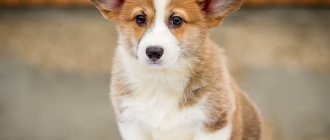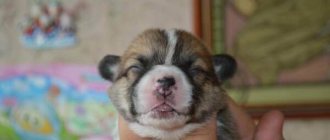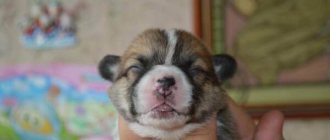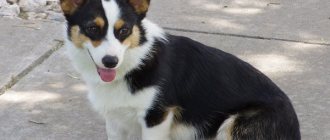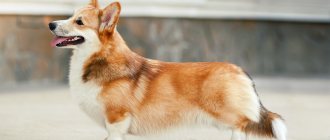Welsh Corgis are sociable, cheerful dogs that are always ready to please their owner.
They lack aggression.
They have a strong and persistent character, high intelligence and a sharp mind.
The height of the Welsh Corgi at the withers is approximately 30 cm, weight reaches 14 kg.
The dog has an elongated body, a wide chest and strong paws.
What do newborn puppies look like in the photo and when do they open their eyes?
Welsh Corgi puppies are born blind and deaf .
In the first days after birth, they are not able to warm themselves on their own, and when performing natural needs they need help. Several times a day, the bitch licks her puppies and thus helps the babies to empty their intestines.
Immediately after birth, they are able to suck, crawl and stimulate their mother's nipples with their paws for better milk flow.
10-15 days after birth, the puppy opens its eyes.
The weight of a healthy newborn Pembroke Welsh Corgi puppy is 300-600 g, size 8-12 cm.
Features of the breed: possible diseases
The Cardigan Welsh Corgi is a fairly healthy breed, and the list of possible diseases is not so long:
- vision problems: retinal dysplasia and atrophy, entropion, glaucoma, lens displacement, persistent pupillary membrane;
- immune deficiency . There is practically no protection against this disease - even vaccinated puppies usually die very early;
- immunoglobulin G deficiency;
- Cystinuria – leads to the formation of stones in the bladder and kidneys. Requires the use of drugs - D-penicillamine, and in severe situations - surgical intervention;
- complications during childbirth due to the structure - childbirth, especially the first one, should take place under the supervision of a veterinarian;
- back diseases - begin with excess weight, which puts pressure on the back. With proper nutrition, this problem does not arise;
- anomalies of intervertebral discs . Can lead to displacement or rupture. To find out whether a particular individual has such a problem, it is worth x-raying the puppy. If an abnormality is detected, it is important to monitor the puppy's activity.
Genetically healthy corgis remain active and cheerful into old age.
How does it develop day by day in the first month?
| Days of the month | What's happening |
| 1-4 | The puppy has a limited supply of energy, no fat layer, and physiological weight loss of about 10% is observed. Pain sensitivity is reduced, the brain is poorly developed. |
| 5-6 | A reflexive chill appears, the nose begins to color. |
| 7-9 | The sense of smell, taste, and twisting reaction are actively developing. |
| 10-15 | The puppy opens its eyes, the pupils begin to react to light. |
| 16-18 | The baby gets up on its paws and tries to wag its tail. |
| 19-20 | The formation of adipose tissue begins, thermoregulation appears. A reaction to noise appears. The puppies start playing with each other. |
| 21-24 | The first baby teeth erupt. The puppy begins to hear. |
| 25-29 | Interest in solid food appears, socialization begins, and the sucking reflex fades. |
| 30 | The presence of primary incisors and canines, the first attempts to leave the nest, increased motor activity. |
Description of the breed
The Cardigan Welsh Corgi is very beautiful and powerful - this is exactly the first impression they make. The breed has a noble head shape, large erect ears, short legs and a specific, very pleasant expression of the muzzle - it seems that the animal is smiling all the time.
Colors
The color of the Welsh Corgi Cardigan can be varied:
- redhead,
- piebald,
- fawn,
- sable,
- red and white,
- tricolor.
The most common cardigans are tiger (brindle) and blue merle (blue merle) , and the rarest are black . There are no only white corgis.
brindle
Marble
Important : Corgis have blue eyes that look very beautiful, but according to breed standards, this color is only allowed for animals with the blue merle color. For other colors, hazel eyes are typical.
Standard
- the head of the Cardigan Corgi is shaped like a fox and a shepherd dog, the skull is wide and flat above the ears, and narrows toward the eye area;
- muzzle – narrowed, but not sharp, nose – black;
- eyes - tonsils, in harmony with the color of the coat;
- bite – full, scissor bite;
- The ears are large, erect, and slightly rounded at the tips compared to the size of the dog;
- the neck is strong and muscular, proportional to the size of the body;
- the body is long and powerful, the chest area is deep, the chest is moderately wide, the croup is sloping;
- The coat is short or medium-long, hard, but silky to the touch, with a thick undercoat. Shines and perfectly protects from moisture;
- The paws are strong, straight, short. The front ones are slightly turned outward;
- the tail also resembles a fox's, of medium length. At rest it hangs freely almost to the ground; when excited it can rise slightly above the top line.
Dimensions
The British have a joke about the corgi: “a dog a yard long.” Indeed, the Cardigan Welsh Corgi is very compact, their ideal height at the withers is 30 cm, the length varies from 90 to 110 cm. The ratio of the length of the back to the height of the animal is important - it should be 3:2.
Height is in the range of 27-32 cm, weight for females - 11-15 kg, for males - 13-17 kg, occasionally - 20.
Weight by month:
| 1 month | 2 kg 300 g – 3 kg |
| 2 months | 2 kg 700 g – 4 kg |
| 3 months | 5 - 6 kg |
| 4 months | 7 - 8 kg |
| 5 months | 8 - 9 kg |
| 6 months | 9 - 10 kg |
| 7-10 months | 10 kg – the weight of an adult dog (11-17 kilos) |
Howl and bark
Good news for those who want to have a corgi: this breed is not inclined to bark over trifles , and it will also not hold “concerts” in an empty apartment while waiting for its owner. Most often, the animal makes a voice when greeting the owner or his guests. Because they are sensitive to the mood swings of others, corgis may bark if they feel something is wrong in the family.
A dog will also bark at a stranger who, in its opinion, is dangerous.
The breed is also characterized by the so-called “ cake songs ” - a howl with modulations, which many find funny. It is performed as a greeting.
In any case, Corgis are easy to train. Therefore, an overly noisy animal is either an anomaly or a consequence of lack of training.
17 reasons why a dog howls and instructions on how to stop it
How does it develop up to a year?
Puppy development from 1 month to 1 year:
| Age (months) | Description | Size(cm) | Weight (g) |
| 1 | The puppy can suck, crawl and move its paws to stimulate the flow of milk from the mother's nipple. In the first half of 1 month, the baby's eyes are tightly closed, he does not hear and cannot independently regulate his body temperature. In the second half of this period, the puppy begins to see, hear, and the first teeth erupt. | 6-10 | 200-650 g |
| 2 | The transition period is from newborn to puppyhood. The puppy is already actively interacting with others, eating solid food, playing, and mastering the rules of the hierarchy. During this period, the baby is separated from the mother. | 10-14 | 320-1050 |
| 3 | The main functions of the dog’s body have already been formed, he continues to actively grow and gain weight, and a daily rhythm begins to form. | 14-20 | 460-1550 |
| 4 | The baby teeth are replaced by permanent ones, and the immune system is formed. | 18-24 | 600-1900 |
| 5 — 6 | Puberty period. Children's character traits clearly manifest themselves, and the leader begins to stand out. This is the beginning of the first sexual games. | 20-28 | 700-2200 |
| 7 | Toy terrier bitches begin their first heat and become fertile. Young males also exhibit sexual activity, but are not yet able to impregnate a female, since their reproductive system is not yet fully formed. | 20-28 | 800-2500 |
| 8 -12 | The dog's growth stops, it begins to grow in strength. The animal tries to occupy a higher position in the hierarchy. And this affects behavior, the pet becomes disobedient, stubborn, and aggressive. | Growth is over | Weight gain stops |
Caring for a pregnant female corgi
Pregnancy is a serious test for a dog's body. To ensure that this period does not have a negative impact on health, the expectant mother should be provided with:
- A special diet with a high content of minerals and vitamins.
- Optimal physical activity.
- Necessary hygiene procedures.
- Regular checkups with a veterinarian.
In the last month, the dog needs to be protected from hypothermia.
A common pathology in corgis during pregnancy is toxicosis. The dog's activity decreases, it sleeps most of the time, becomes nervous, and loses its appetite. These signs usually appear in the first half of the term and last about 3.5 weeks. They pass without intervention and should not disturb the owners. If toxicosis persists, you should consult a veterinarian.
The birth of puppies as a result of natural birth is observed only in half of the cases. Due to the large size of babies, a caesarean section is often necessary.
How to care?
Caring for a Pembroke baby should include :
- Proper nutrition. The pet's diet must contain all the necessary vitamins and microelements. The puppy's diet must contain a sufficient amount of meat.
- Daily walks are a prerequisite for the normal development of a dog. In addition, the puppy should be given moderate physical activity.
- Inspect and clean your pet's eyes and nose daily.
- Once every 3 weeks, the puppy should have its nails trimmed.
- Be sure to give your dog vitamins and special supplements for bone growth and strength.
- Once a week, the baby’s teeth are brushed with a special brush.
- The pet should be bathed approximately once every 2-3 months, using shampoos designed specifically for dogs.
- Accustom your dog to a collar and leash as early as possible for his own safety.
- Give your dog anthelmintic medications once every 3 months.
- Take your dog to the veterinarian every year.
- Give your pet a hygienic haircut once every six months.
Specifics of caring for the elderly
Elderly pets require special care. At this age, the processes of digestion and metabolism slow down, and a special diet is required. Physical activity decreases and the risk of developing diseases increases. Special care rules include:
- A light diet, in which vegetables occupy a large part, the volume of cereals and meat foods is minimized. You can give special ready-made food for older dogs.
- Reducing the duration of walks.
- Contact a veterinarian if the slightest signs of disease appear.
Every dog lover who wants to get an energetic and cheerful corgi puppy should study the information about the rules of care and evaluate their capabilities in order to make the right decision. You should buy a pet only if there is no hesitation or doubt.
What to feed for the first 3 months?
The food your pet eats should be light but nutritious, with a predominance of meat products..
The second important component is fermented milk products. They will ensure proper bowel function and also satisfy the body's calcium needs.
Products that should be included in the diet:
- Meat (chicken, beef, turkey).
- Porridge (rice, buckwheat, oatmeal).
- Eggs at least once a week.
- Fermented milk products (kefir, yogurt, cottage cheese).
- Offal (heart, liver, lung, etc.).
- Vegetables and fruits.
Gluing the dog's ears
Of course, every owner can master gluing up a pet’s ears. You don't need to go to the vet for this. To fix the ear problem, you will need: a medical plaster, two centimeters wide, scissors, a splint in the form of a pen rod or a match without a head. The latter should be long, slightly less than the dog’s ear, light and thin.
Before starting the gluing process, be sure to wipe the ear with alcohol and let it dry. This will prepare the ear for gluing: it will degrease and disinfect. Surely, you will need an assistant in this matter if the dog is very active.
First you need to cut out two pieces of plaster in the shape of a petal. They will be glued to the inside of the dog's ear. The width and length of such a petal correspond to the shape of the ear cartilage. It is important that the cut petal covers its entire length: from tip to curl. Next, you need to place the “tire” between the petals in the center and mold them together so that one side remains sticky. Before gluing to the ear, the structure must be smoothed. It should be without wrinkles, smooth and strong. Such an auxiliary structure is capable of supporting the animal’s ear in a raised state.
Usually, pets' ears are glued from two or three months. The adhesive plaster structure is removed when the dog’s teeth are replaced with permanent ones. If the dog destroys such an auxiliary device with its paw, then you will have to work hard again.
It should be taken into account that not every puppy will tolerate gluing well. Some people may have an allergic reaction to the adhesive part of the patch.
During the bonding period, your dog’s diet must be enriched with calcium-containing supplements so that the ear cartilage is also strengthened from the inside. Some dog breeders recommend simply giving your dog calcined cottage cheese. To do this, bring 500 grams of milk to a boil, remove from heat and immediately add a tablespoon of calcium chloride. The finished cottage cheese is placed in a colander.
Source
How to feed correctly and how often?
Proper nutrition for a puppy is a balanced diet, frequency of feedings and volume of portions.
A very small puppy is fed in fractional portions at least 6 times a day.
Starting from 3 months, the baby can be given food 5 times a day.
From 6 months of age, the dog needs 3 meals a day.
At 10 months the pet is fed 2 times a day.
Menu for the week
Monday:
- Breakfast - cottage cheese or yogurt.
- Lunch – Rice porridge with liver.
- Dinner – a piece of fish.
Tuesday:
- Breakfast - kefir or cottage cheese.
- Lunch – buckwheat porridge with boiled turkey meat.
- Dinner – stewed cabbage, chicken.
Wednesday:
- Breakfast – cottage cheese or low-fat broth.
- Lunch – oatmeal with boiled beef.
- Dinner – stewed beets and a piece of fish.
Thursday:
- Breakfast: cottage cheese or yogurt.
- Lunch – low-fat broth and boiled egg.
- Dinner – zucchini, a piece of chicken.
Friday:
- Breakfast - cottage cheese.
- Lunch – buckwheat porridge with heart.
- Dinner – stewed pumpkin and rice.
Saturday:
- Breakfast – boiled fish.
- Lunch – buckwheat porridge with scalded liver.
- Dinner – boiled beef.
Sunday:
- Breakfast - yogurt, cottage cheese or kefir.
- Lunch – buckwheat porridge with fish.
- Dinner – stewed beets.
Vaccination schedule
Mandatory vaccination schedule for Pembroke Welsh Corgis:
- At the age of 8-10 weeks, the dog suffers from distemper, lepospitosis, and parvavirus enteritis.
- At 12-14 weeks, the dog is vaccinated against all of the listed diseases and given an additional vaccination against rabies.
- At the age of 12 months, vaccinations are repeated.
IMPORTANT!
Vaccination is repeated annually throughout the dog's life.
When re-vaccinating, it is necessary to use the vaccine from the same manufacturer as the first time.
Mating
Before mating, animals undergo a health check. The presence of genetic diseases is checked. It is also not recommended to breed aggressive, nervous individuals. According to standards, long-haired individuals are also not bred.
The required age for mating is considered to be 2 years for males and 8 months for females. The girl undergoes preparatory measures before mating: prevention against parasites, vaccinations, checking the condition of the heart and thyroid gland. Corgi girls over 9 years old are not allowed to breed.
When mating, the boy and the girl first meet, then they walk together. If everything went smoothly, they are left alone in the communication room.
Pregnancy in female corgis lasts just over two months. The number of puppies in the litter is from 3 to 8.
How to bathe?
Basic rules for bathing a puppy:
- Bathing should begin no earlier than 2 weeks after vaccinations are given.
- Once a month is the maximum frequency of bathing.
- When bathing, be sure to use a rubber mat or diaper to prevent the puppy's paws from moving apart.
- The water temperature for swimming should be 38-39 degrees.
- Before bathing, plug your dog's ear canals to prevent water from getting in.
- Use only shampoos designed for dogs when bathing.
- After bathing, immediately wrap your baby in a soft towel and dry thoroughly.
- If necessary, dry your pet with a hairdryer.
- For 2-3 hours after bathing, the dog should be in a warm room without drafts.
- You can walk with your pet only the next day after bathing.
Baby teeth and cleaning them
Puppies' first teeth appear on days 20-25 of life . The right canines erupt, then the premolars, incisors and molars.
By the end of the second month, your Pembroke Welsh Corgi puppy should have 28 baby teeth.
The most important aspect of dental care is brushing. The procedure is carried out using a special brush and toothpaste intended for dogs.
Start brushing with the front teeth, and then gradually move on to the premolars and molars.
Brush your teeth in a circular motion. This not only cleanses the teeth, but also massages the gums.
Owner reviews
My dog turned out to be not very sociable; she treats strangers with suspicion. It is ideal for keeping in an apartment. The dog is interesting, if you decide to get a Cardigan Welsh Corgi for your home, you definitely won’t get bored.
Tanya1975
https://otzyv.pro/reviews/otzyvy-kardigan-velsh-korgi-85196.html
An excellent breed, practically unspoiled by breeders, very friendly, very family-oriented, very sociable dogs that get along well with everyone and love children very much.
Mermaid
https://forum.auto.ru/brothers/307201/
Cardi, as we affectionately call dogs of this breed, are real shepherds. They have a very high level of intelligence, good health, endurance and unpretentiousness.
Julia and Nika
https://bvf.ru/forum/showthread.php?t=960672
The Cardigan can be called a universal dog. He has the qualities of a companion, shepherd and guard. The dog is undemanding to living conditions and feels good in a city apartment. But the owner should take into account the genetic characteristics of the cardigan, which were formed based on the experience of his ancestors.
- Author: Yana Dmitrova
Hello! Let's get acquainted, my name is Dmitrieva Yana, a manager of foreign economic activity by education. Rate this article:
- 5
- 4
- 3
- 2
- 1
(1 vote, average: 5 out of 5)
Share with your friends!
Is it necessary to dock the tail and when to do it?
In European countries, tail docking is prohibited for dogs.
The standards
of the Russian Federation state that the tail of the Pebroke Welsh Corgi should be natural and low set or docked . Therefore, the final choice remains with the breeder.
Differences from Pembroke
For a long time, these breeds competed with each other at exhibitions, but today they are often confused. Meanwhile, their differences (as well as similarities) are clearly expressed:
- Story . They were brought not by the Celts, but by Flemish weavers.
- Size . Cardigans are larger and wider in the bones, their body and head are larger. The weight of Pembrokes does not exceed 14 kg.
- Ears . Cardigans have much more rounded tips.
- Color . Unlike Cardigans, who have many coat color options, Pembrokes have a strictly regulated coat color: red, sable or black.
- Tail . Among the Pembrokes, it was previously stopped without fail. Today, not everyone adheres to this tradition, but bobtail is still common. But cardigans have a tail that is always long, fluffy and very beautiful. Before docking was abolished, it was easiest to distinguish them “by the loin part.”
- Character . Pembrokes are considered more friendly and sociable. Cardigans are also affectionate with their owners, but behave reservedly around strangers. Loneliness is easier to bear.
- Because of their different ancestors, Cardigans and Pembrokes have different genetic conditions and disease susceptibilities . For cardigans, this list is a little smaller.
The most smiling dogs in the world: Pembroke Welsh Corgi
The breeds are similar, first of all, in size, affection, and charming appearance, reminiscent of both a dog and a fox. Both Cardigans and Pembrokes are highly trainable, love new tricks and pick them up literally on the fly. Both varieties are suitable for inexperienced dog owners .
How to train and what commands to teach?
Start training your dog by teaching him his name.
At the same time, accustom the dog to the rules established in the family. Show your pet his place and immediately begin practicing the “place” command.
The next stage is prohibitions; clearly outline the boundaries of what is permitted and immediately stop unacceptable behavior. At this stage, teach the puppy the “fu” or “no” command. .
During daily walks, the dog must be taught the “come to me” command and the “fetch” command.
How to choose?
When choosing a pet, pay attention to the following factors:
- Puppy behavior. A healthy pet will always be active, cheerful, and inquisitive. He has a good appetite, a relaxed gait and a great desire to explore the world around him.
- The baby should not have any discharge from the nose, ears or genitals, and the pet's eyes should be clean.
- Conditions in the nursery. The place where kids live should be clean, spacious, and warm.
- Baby's mother. If she looks unhealthy, is too thin or behaves inappropriately, then this is a reason to think about it.
- Talk to the breeder, find out about the availability of documents. You must be shown the puppy's veterinary passport, puppy card and documents from the parents.
- Talk to experienced dog breeders and ask about the reputation of the kennel.
Why doesn't the puppy have ears?
Among the possible causes, there are only 3. They are associated with poor nutrition, injuries and the individual characteristics of the pet.
Lack of vitamins
Ear cartilage needs a lot of calcium. When there is a shortage of it, the body directs its main reserves to more important structures: joints, teeth and bones.
Cartilage problems
The baby can damage the ear linen during games or fights. It can also be accidentally pinched by the owner who did not notice the puppy hiding behind the door. If the injury is serious, surgery will be required to repair the cartilage.
Another possible reason is the meatiness of the canvas itself. Additional support is required for proper placement. It is achieved by gluing.
Genetic predisposition or marriage, crossbreeding
Pets born from parents with weakened ears often suffer from a similar problem. Despite the complexity, lop ears in this case are completely solvable.
The erect ears will have to be abandoned only if the marriage caused by cross-breeding is confirmed. For this reason, you should not buy animals secondhand. An unscrupulous seller may sell you a puppy from a lop-eared dog. In such a situation, all methods are ineffective.

